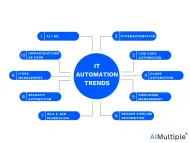Programmable Infrastructure in 2024 & 3 Use Cases
Digitalization changes the nature of business environments, resources, and infrastructure. In the rapidly changing tech world, enterprises have to become more agile and efficient in delivering business value.
One of the recent approaches adopted by enterprises to protect agility and efficiency is having a strategy to manage infrastructure successfully. Programmable infrastructure refers to a strategy that helps enterprises manage the infrastructure’s complete lifecycle and its deployment process while eliminating complex processes that depend on the hardware.
Programmable infrastructure can help enterprises boost efficiency and agility in providing services. This article will explore use cases of programmable infrastructure, its benefits, and preconditions for implementation.
What is programmable infrastructure?
Programmable infrastructure is defined as the utilization of tools and methods from software development to effectively manage data centers, on-premises, or clouds. This changes the way infrastructure is deployed by treating infrastructure as a code instead of traditional manual methods. As IT environments evolve, enterprises adopt new strategies to transform their infrastructure.
From cloud to legacy, IT environments vary significantly. Managing IT environments often becomes a challenge for enterprises as their complexity deepens. Although legacy environments contribute to business processes, they are inefficient and hard to manage. To solve this inefficiency, a programmable infrastructure (see Figure 1):
- Accepts existing infrastructure like software and implements an API,
- Turns the infrastructure into a programmable shape,
- Allows users to automate processes and improves efficiency in IT.
Figure 1: Illustration of programmable infrastructure workflow
Source: LinkedIn
3 Use-cases of programmable infrastructure
1. Deployments on cloud
Through programming infrastructure, IT teams can deploy resources on the cloud and manage them effectively. It is implemented through templates according to business policies and practices. These templates are mostly used for hybrid-cloud enterprises with a single template.
2. Infrastructure testing
IT teams can test their production environments and diagnose errors in projects. This can be automated and replicated in subsequent projects. Information is gathered and the results are assessed. In addition, testing can be carried out without interrupting other services.
3. Monitoring
It enables IT teams to monitor various processes and environments. It is not just application monitoring, but more of it. Programmable infrastructure focuses on infrastructure-level reports and alerts for errors. It helps teams to find out performance data as well as where and when errors arise.
Benefits of programmable infrastructure
- Programmable infrastructure removes manual processes and automates system configuration processes. It not only speeds up the processes but also enhances consistency by reducing errors and improving quality.
- As programmable infrastructure allows sources to be defined as a code, users are able to monitor and update changes. In case of failure, the process is saved, and it is possible to return earlier versions thanks to coding.
- It reflects exactly what it is. As it is based on coding, it does not diverge from what is defined. Other methods, such as runbooks, often fail to show what they are meant to be.
- Thanks to its replicability, it can be repeated for other applications by rerunning the code. Therefore, testing and staging environments are easily rebuilt for the production environment. Therefore, testing and staging environments are rebuilt for the production environment easily.
3 Steps to programmable infrastructure
1. Designing APIs
The application programming interface is an essential criterion for the successful construction of programmable infrastructure. It must be well-defined and designed in order to open interactions easily.
A quick tip: Adopt ready-to-use APIs. This will save your time and speed up the construction of a programmable infrastructure.
2. Testing mechanism/framework
The test mechanism or framework creates a safety strategy in terms of error prevention. Based on criteria that trigger automation such as code, audits, and compliance, testing can minimize risks and eliminate failures.
A quick tip: Ensure that your testing mechanism or framework is well-defined. Create a testing mechanism and incorporate your success criteria.
3. Self-service Platform
Self-service platforms maintain business agility. Any task, service, or workflow can be automated on self-service platforms integrated with infrastructure automation software, eliminating the need for experts.
A quick tip: Create a self-service platform to automate the most used services in your enterprise.
Further Reading
To learn more about automation and orchestration, feel free to read our articles:
- 5 Factors to Consider When Selecting Infrastructure Automation Tools
- 4 Ways to Improve Your Business with Self-Service Automation
- 4 Ways to Boost IT Operations with Event-Driven Automation
If you are looking for automation and orchestration tools, you can visit our hub for the automation software landscape.
If you have other questions about programmable infrastructure, we can help:

Cem has been the principal analyst at AIMultiple since 2017. AIMultiple informs hundreds of thousands of businesses (as per similarWeb) including 60% of Fortune 500 every month.
Cem's work has been cited by leading global publications including Business Insider, Forbes, Washington Post, global firms like Deloitte, HPE, NGOs like World Economic Forum and supranational organizations like European Commission. You can see more reputable companies and media that referenced AIMultiple.
Throughout his career, Cem served as a tech consultant, tech buyer and tech entrepreneur. He advised businesses on their enterprise software, automation, cloud, AI / ML and other technology related decisions at McKinsey & Company and Altman Solon for more than a decade. He also published a McKinsey report on digitalization.
He led technology strategy and procurement of a telco while reporting to the CEO. He has also led commercial growth of deep tech company Hypatos that reached a 7 digit annual recurring revenue and a 9 digit valuation from 0 within 2 years. Cem's work in Hypatos was covered by leading technology publications like TechCrunch and Business Insider.
Cem regularly speaks at international technology conferences. He graduated from Bogazici University as a computer engineer and holds an MBA from Columbia Business School.
To stay up-to-date on B2B tech & accelerate your enterprise:
Follow on

Comments
Your email address will not be published. All fields are required.